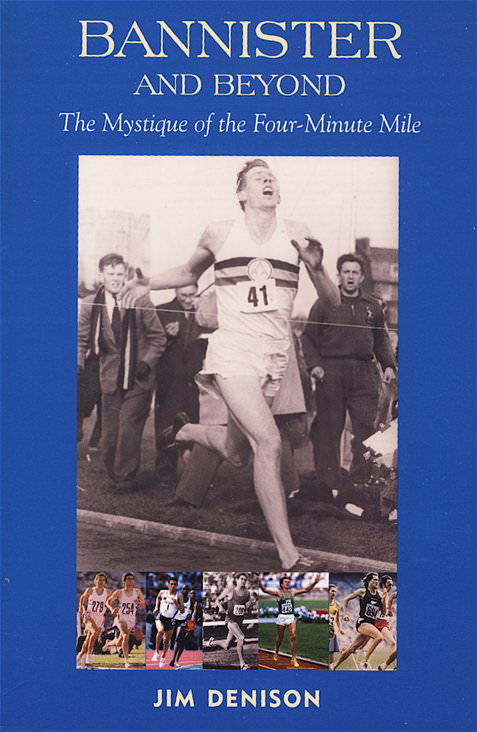Book Review
Bannister and Beyond: The Mystique of the Four-Minute Mile
by Jim Denison
Breakaway Books, New York, 2008 256pp
Jim Denison, Associate Professor at the University of Alberta, finds it “a strange omission of history” that “few records or statements exist besides Bannister’s own literary account of 1955 of how it actually feels to break four minutes for the first time.” In this book, he aims to redress this omission by interviewing 21 four-minute milers. As well as getting detailed accounts of their first sub-four, he asks them to describe the “meaningfulness and significance of breaking four minutes.”
He has chosen an interesting mix. There are the great milers from Bannister and Landy to Steve Cram and Noah Ngeny. Then there are lesser known and more contemporary runners like Jama Aden and Mike East. As well, there is a wide variety: Africans, Americans, Australasians, and Europeans.
 |
Denison is a fine interviewer. He starts every interview in a different way before zeroing in on the actual first sub-four Mile. His initial open question is always able to get the interviewee talking in detail right away. For example, he first asks Steve Cram if he felt pressured to live up to “the expectations of being a British miler.” He obviously hit on an issued Cram felt strongly about, for the answer takes up 25 lines. When Denison asks a young Mike East if he dreams to emulate his British countrymen with a Mile world record, he gets a surprising but interesting answer that starts with “Not really.”
As Denison zeroes in on each runner’s sub-four, he does so in a coherent and smooth manner. And although there could easily be a repetitive quality to the interviews, Denison manages to produce great variety. Each one is also an effective character study as well as an insight in to the experience of first breaking four minutes. Of the 21 interviews, I found 13 to be of great value, five useful and only three disappointing. All of them had good points to make on the main theme of the book.
One of the best interviews was with Irishman Desmond English. A very articulate man, English explains the mystique of the first four-minute Mile, but then goes on to explain that in the interest of his career he must run the 1,500 and not the Mile: “But honestly, running a Mile is almost a luxury.” After a very interesting description of the difference between the 1,500 and the Mile, English gives perhaps the best description of his first and only sub-four Mile. As a 1:48 800 runner, he was forced into a Mile race against Eamonn Coghlan (PB 3:49) and David Kibet (PB 3:51). “I was having a great time… I wasn’t feeling any pain at all. Now with 200 to go, my parents and my cousins and all my mates were going mad from the side of the track. I could hear them as clear as day…. Then with 100 to go I hit the lead…amazing really. But it was right after that when I knew I was a visitor to the Mile. In about five strides I got hit with the most incredible wave of pain.” English finished fourth but he still broke the barrier with 3:58.71.
Denison’s interviews bring out the different ways the barrier was broken, from careful planning to unanticipated. It is striking that all interviewees have vivid memories of their first sub-four. Walker, for example, was angry because he was put in the B race at a meeting in Canada as his PB was 4:06. He ran almost the whole race at the front and finished in 3:58.8. Another Kiwi, John Davies, provided enough detail on his first sub-four to cover a page, his time sub-four coming from a very close race with Peter Snell.
Now that almost all track races are metric, except in the USA, the Mile is not run very often. The older interviewees argue that the Mile will endure, while the younger ones, although agreeing that it will survive as a track race, regard it as quaint and peripheral. Thus John Walker (b. 1952) asserts, “The Mile is without question the most significant in track and field.” On the other hand, Mike East (b. 1978) tells Denison, “The 1,500 carries so much more currency than the Mile…. [but] guys are always going to want to run a Mile.” Virtually all the interviewees express great satisfaction from breaking the 4:00 barrier. Denison concludes in the Epilogue that “the future of the four-minute Mile seems secure.”
Bannister and Beyond is impressively produced. The cover is eye-catching, with a larger black-and-white photo of Bannister hitting the tape in 3:59.4 and five much smaller colour photos below (Coe, Ngeny, Ryun, Coghlan and Walker). The format for the interviews includes a small black-and-white photo and a brief introduction that approaches the interview obliquely. My only quibble with the formatting is that the questions and answers are indistinguishable on the page. I would have liked the questions in a different font or in italics.
Ultimately, Denison’s fine interviews do more than explore the relevance of the four-minute Mile and the interviewees’ first sub-four. There is a wealth of historical material and insights into the way runners achieve success. This book should be in all libraries. 
Highly recommended
Leave a Comment